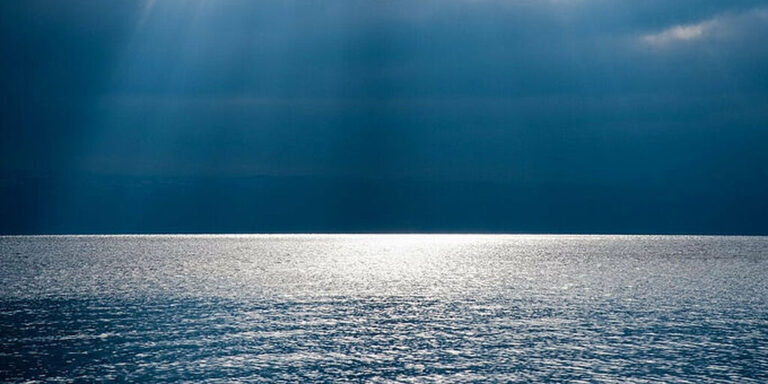Photo: catherineasquithgallery.com
I have just now finished re-reading the seminal 2007 book
The Language of God,
written by physician-geneticist and Christian Francis
S. Collins, the man under whose leadership the Human
Genome was finally mapped in 2003. It is an inspiring
read. One might imagine that it was the overwhelming
proof for evolution that undergirds a non-historical
reading of the first chapters of Genesis. In my own
case the scientific proof of evolution formed no part
of my regarding the Genesis creation stories as
non-historical. I rejected an historical reading of the
text because I took the text with absolute seriousness
as the Word of God. That is, I took seriously what it
had to say about the sea.
We find the sea in the second verse of the first creation
story, in Genesis 1:2. The chapter begins, “In the
beginning God created the heavens and the earth, and the
earth was tohu and
bohu”—often (misleading) rendered
“formless and void”, but better rendered as
“desolate and empty”.
Then comes the reference to the sea: “Darkness over
the face of the deep [Hebrew tehom], and the
Spirit of God was brooding over the face of the waters
[Hebrew mayim].
The word tehom is used in Isaiah 51:10 to
describe the Red Sea; in Jonah 2:5 it describes the
Mediterranean Sea; in Ezekiel 26:19 it also refers to the
sea. The word mayim is simply the usual plural
word for water (compare its use in Exodus 17:6, where
water came from the rock). We can understand the nature of
this tehom, these mayim, when we read
the verses that follow.
God did not begin to create until the first day of
creation, narrated in verse 3, when He said, “Let
there be light”. After that, on the second day of
creation, God said, “Let there be a
raqia’ in the midst of the waters, and let
it separate the waters from the waters.” The
narrator goes on to say, “And God made the
raqia’ and separated the waters which were
below the raqia’ from the waters which were
above the raqia’, and it was so. And God
called the raqia’ “heavens” (in
the plural; Hebrew shamayim).
What was this “raqia’”? The
word is cognate with the verb raqa, which means
“to hammer out”, the verb used in Exodus 39:3
to describe the process of hammering out gold plate for
use in the Tabernacle shrine. Here the noun refers to the
solid sky, something strong and sturdy enough to hold up a
large amount of water.
This was in keeping with ancient cosmology, which
considered that there was a sea up above the clouds, which
sea was the source of rain that came down through the
windows of the raqia’ and which were caught
by the buckets of clouds (compare Genesis 8:11), and that
the sky was solid enough to keep the sea up there safely
away from us. This belief is reflected in Job 37:18, which
describes the sky [Hebrew shehaqim] as
“hard as a molten mirror”.
We continue with the creation narrative. On day three God
said, “Let the waters under the heavens be gathered
together into one place, and let the dry land
appear”. The narrator then related, “And it
was so. God called the dry land ‘earth’, and
the waters there were gathered together He called
‘seas’.”
Here we need to read carefully, determined to take the
text seriously and not import our own scientific
understanding into it. Note that the waters down here
below that were gathered together and called
“seas” were exactly the same waters that were
just separated from the waters pushed up above and kept
away from us by the raqia’. Note too that
these waters, both those above the raqia’
and those down here below the raqia’ which
we experience as the seas, were the waters over which the
Spirit of God brooded before creation began.
Let us connect the narrative dots: what we experience now
as “sea water” once existed before creation
began. This was the tehom that existed when
everything was tohu and
bohu. Note too that God did not
create the dry land; the dry land simply appeared when God
gathered the waters under the heavens into one place, thus
making what we call “seas”.
According to the text, the dry land was already present, but it was submerged under the waters of the primordial sea. This suggests that the seas are remnants of the original chaos before God’s creation began. The Biblical ambivalence towards the sea reflects a desire to protect creation from chaos, as seen in verses like Job 38:11 and Revelation 21:1. The Genesis creation story aligns with ancient Near Eastern cosmology, portraying the sea as the source of primordial chaos. The Bible reflects the prevailing views of the ancient Near East on various topics, such as the sun’s movement and the functions of the heart and kidneys. It is a mistake to interpret the Genesis creation stories as providing accurate scientific information; their main purpose is to convey lessons about God and His relationship with His people. Reading the creation story in context with ancient cosmology helps us understand its unique teachings about God’s covenant. We should not alter the text to fit our beliefs, but instead adjust our interpretations to align with the Word of God.
Source link

